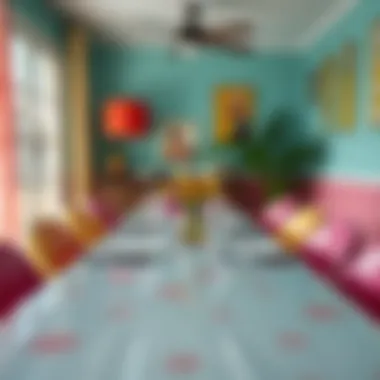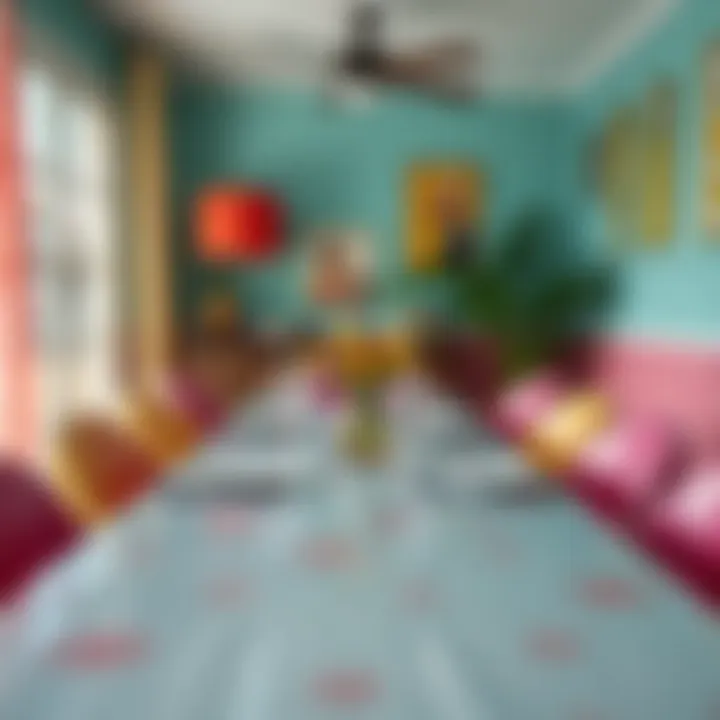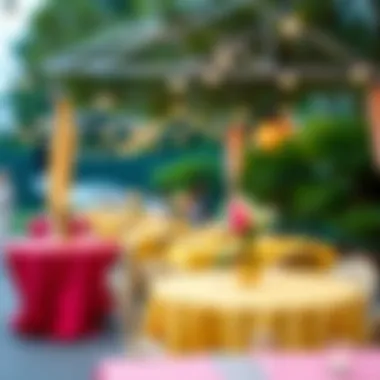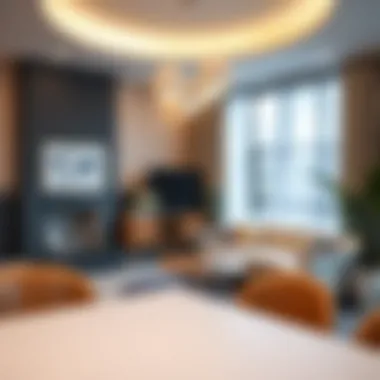Discovering the Multifunctionality of Plastic Tablecloths


Intro
In the realm of interior design and event planning, plastic cloth tablecloths have emerged as a preferred choice, proving their worth far beyond mere functionality. These versatile coverings are not just utilitarian items, but they also come packed with a variety of aesthetic and sustainable options that appeal to a wide range of consumers—from homeowners to professional event planners. As we delve deeper into the multi-faceted world of plastic cloth tablecloths, it becomes clear that their adaptability is one of their most compelling features.
Plastic cloth tablecloths offer a unique solution for those who seek practicality without sacrificing style. Whether you're sprucing up a dining room or preparing for an outdoor gathering, the choices abound. This article will unpack the various attributes of these table coverings, explore current design trends, provide useful tips for maintenance, and consider the environmental implications of choosing plastic cloth over traditional fabrics. With these discussions, we aim to highlight how plastic cloth tablecloths can effectively elevate spaces and occasions alike.
Understanding Plastic Cloth Tablecloths
Plastic cloth tablecloths have gained recognition as a reliable option for both everyday and special occasions. The versatility and functionality of these coverings have made them a staple in many households, event venues, and commercial settings. By diving into the characteristics of plastic cloth tablecloths, one can equipped themselves with an understanding that goes beyond mere aesthetics. It’s about the durability, ease of care, and designs that can transform any dining experience.
Definition and Composition
Plastic cloth tablecloths, fundamentally, are made from synthetic materials like polyethylene or PVC that deliver both function and style. Unlike traditional cloth table linens, they are engineered to resist spills and stains, providing a more user-friendly experience. This unique composition helps maintain their appearance even after multiple uses. Not only does this mean they last longer, reducing the need for frequent replacements, but they also stand up against the wear and tear inherent in active environments—think busy family dinners or lively outdoor barbecues.
The lightweight nature of these tablecloths makes them an attractive choice for decorators. They can be easily draped over tables, giving a refined look without the hassle of heavy lifting. Moreover, many varieties are treated for added protection against fading and tearing, which enhances their longevity further. The blend of functionality with eye-catching designs demonstrates why many homeowners opt for plastic cloth tablecloths.
History of Plastic Table Coverings
The humble roots of plastic table coverings can be traced back to mid-20th century innovations in synthetic materials. Initially developed for their practicality, these tablecloths began surfacing in American households as an alternative to more traditional fabrics. As lifestyle changes evolved, especially during family-oriented gatherings, so did the demands for table décor that could withstand the unpredictable nature of dining with children or hosting outdoor parties.
During the 1970s, people truly embraced the colorful and vibrant styles that plastic cloths offered. The introduction of patterns and various colors allowed for creative expression, turning tables into features rather than mere surfaces for dining. Through the decades, businesses recognized the market potential and began producing plastic tablecloths en masse. Today, they are available in a plethora of styles and even eco-friendly versions that cater to the increasingly conscientious consumer.
As society continues to place value on sustainability and design, the evolution of plastic cloth tablecloths is expected to progress further, making them not just a functional item, but a focal point in contemporary dining aesthetics.
Advantages of Plastic Cloth Tablecloths
Plastic cloth tablecloths have carved out a significant niche in the realm of home decor and event planning, and it’s no wonder why. Their allure lies not only in their practicality but also in a myriad of benefits that make them a go-to choice for diverse situations. Understanding these advantages gives homeowners, designers, retailers, DIYers, and students deeper insights into why choosing plastic cloth tablecloths can elevate both the functionality and aesthetics of any space.
Durability and Longevity
When it comes to durability, plastic cloth tablecloths often take the cake. Unlike their fabric counterparts, which may fray or wear out after a few washes, plastic tablecloths are designed to withstand the rigors of daily use. They are resistant to tearing, staining, and fading, which means that those vibrant colors and patterns can remain intact for numerous gatherings.
Moreover, the longevity of these tablecloths can lead to long-term savings. Instead of frequently replacing worn-out textiles, opting for a durable plastic option can minimize ongoing costs. Homeowners will find that just a quick wipe down or rinse is often all that’s required to keep them looking fresh. This resilience makes them suitable for everything from casual family dinners to outdoor barbecues and festive celebrations.
Ease of Cleaning and Maintenance
The hassle associated with cleaning traditional fabric tablecloths can be quite a deterrent for many. Imagine hosting a lively dinner party where spills and mess are just par for the course. This is where plastic cloth tablecloths shine. The majority of these table coverings are designed to be wiped clean with just a damp cloth, saving both time and effort.
- Spill Friendly: Whether it's a splash of red wine or a dab of ketchup, plastics are generally easy to clean and don't absorb stains as fabrics do.
- Machine Wash vs. Wipe Down: Say goodbye to the chore of separating whites from colors. With plastic, a simple cleanup without the need for washing machines becomes possible.
These benefits not only simplify post-event cleanup but also allow for a carefree atmosphere at gatherings. Guests can relax and enjoy without worrying about unintended stains ruining a decorative element.
Cost-Effectiveness Compared to Other Materials
In terms of budget, plastic cloth tablecloths often emerge as the winner. Consider the initial investment: fabric tablecloths can range dramatically in price, especially those made from quality materials. Their ongoing maintenance cost, including washing and ironing, can also add up in the long run. Plastic cloths, by contrast, come in a variety of price points that accommodate nearly any budget.
- One-Time Investment: With many plastic options being affordable, it’s easy to outfit tables for large gatherings without breaking the bank.
- Reusable Potential: Many plastic tablecloths are made to be reused several times, providing great value over time.
Plus, many retailers offer bulk purchasing options which can further reduce costs, especially for event planners who may require large quantities. This smart choice can stretch budgets further, allowing for investment in other decorative elements or necessities.
Ending


With all these advantages considered, plastic cloth tablecloths present a compelling case for anyone seeking versatility, efficiency, and a budget-friendly solution. Their resilience, easy maintenance, and cost-effectiveness make them an excellent choice for various settings, promising both aesthetic appeal and practicality to any space.
Design Versatility
Design versatility is one of the most significant aspects of plastic cloth tablecloths, acting as a canvas that allows creativity to flow in various settings. These table coverings offer homeowners, designers, retailers, and DIY enthusiasts an incredible opportunity to express personal style while ensuring practicality. The array of options available can turn an ordinary table into a vibrant focal point, making it essential to explore how design versatility enhances both function and aesthetics.
Patterns and Colors Available
When it comes to patterns and colors, the choices in plastic cloth tablecloths are nothing short of dazzling. From bold geometric designs to soft florals, there’s something for every taste. The vibrant hues available can complement or contrast with existing decor, making it convenient to refresh a space without much hassle. For instance, a bright red and white checkered tablecloth can evoke a sense of picnic charm, while sleek black or navy options add a touch of sophistication for more formal gatherings.
- Solid Colors: Easy to match with various dishes, these are a staple in any setting.
- Patterns: Checks, stripes, and polka dots bring liveliness to casual dining.
- Custom Designs: Some vendors offer personalized tablecloths, perfect for special occasions or branding.
The versatility in designs ensures that whether you're hosting a casual brunch or a lavish dinner party, there is a plastic cloth table covering that fits right in.
Seasonal and Thematic Uses
Seasonal decorations can often feel like a chore, but with plastic cloth tablecloths, it becomes quite simple. Imagine a Thanksgiving feast adorned with a harvest-themed design, or a summer barbeque celebrated with bright florals or tropical motifs. Quick changes can easily adapt dining areas to match upcoming festivities or reflect the current seasons, keeping the mood fresh.
Some popular seasonal uses include:
- Spring: Floral or pastel designs for Easter brunches.
- Summer: Bright colors and beach themes for Fourth of July picnics.
- Fall: Warm colors and rustic patterns for Thanksgiving dinners.
- Winter: Elegant designs or winter wonderland themes for holiday parties.
The ability to switch out tablecloths with the seasons makes it easy for anyone to enjoy diverse atmospheres without breaking the bank.
Integration with Different Decor Styles
Plastic cloth tablecloths are adaptable to various decor styles, making them a practical choice for any setting. Whether your style leans towards modern minimalism, vintage charm, or eclectic bohemian, there’s a plastic tablecloth that can seamlessly fit in.
- Modern: Sleek, monochromatic tablecloths enhance a contemporary vibe.
- Rustic: Linen-like textures with earthy tones work wonders for farmhouse aesthetics.
- Bohemian: Bright colors and patterns appeal to those who love a fusion of cultural styles.
With this flexibility, not only do these tablecloths serve a purpose during meals, but they also contribute to the overall design narrative of a room or outdoor space by maintaining coherence across various elements.
"The value of design versatility in plastic cloth tablecloths is not just about aesthetics; it’s about creating an experience that resonates with the essence of the occasion."
By exploring the breadth of designs available and their ability to match seasonal and thematic elements, one can fully appreciate how plastic cloth tablecloths bring creativity, efficiency, and a personal touch to any table setting.
Applications of Plastic Cloth Tablecloths
The relevance of plastic cloth tablecloths spans a multitude of settings and occasions, making them adaptable and practical tools for both beautifying spaces and protecting surfaces. Their convenience, along with a variety of styles and designs, opens doors for both everyday use and special events. They have truly become indispensable in our modern lives, proving their worth in households, at gatherings, and in commercial venues.
Everyday Use in Households
In daily life, plastic cloth tablecloths serve as effective protectors for dining tables, coffee tables, and even crafting stations. Families often gravitate towards them due to their resilient nature. When kids are around, accidental spills are nearly a given. A plastic cloth table covering can be wiped down with a simple cloth or sponge, saving both time and effort. Moreover, these tablecloths come in an assortment of colors and patterns, allowing homeowners to reflect their personal style while keeping furniture intact.
A few practical benefits include:
- Affordability: Available in various price points, plastic cloths can fit nearly any budget.
- Versatility: Easily switched out to complement seasonal décor or special occasions.
- Variety: Patterns can range from cheery florals to sleek modern designs, catering to different aesthetics.
Events and Outdoor Gatherings
When it comes to events, whether they are birthday parties, BBQs, or weddings, plastic cloth tablecloths shine through. Their ability to endure outdoor elements cannot be overstated. Rain? No problem. Spills from icy drinks? Easy clean-up. They allow for spontaneity in planning outdoor gatherings without the constant worry of damaging expensive linens.
"Plastic cloth tablecloths are a practical choice for managing the unpredictable nature of outdoor events, letting hosts enjoy their time without fretting over the mess."


Using plastic cloths outdoors can also mean:
- Accessibility: Affordable enough for large gatherings, making it viable to cover many tables.
- Theme Coordination: With options that cater to themed parties, it's easy to find the perfect match.
- Reusable Options: Selecting reusable, high-quality plastic covers can further minimize waste while remaining stylish.
Commercial Settings and Catering
In commercial environments, plastic cloth tablecloths become not just a matter of aesthetics, but also functionality. Restaurants, catering businesses, and event planners utilize them for their practicality and enduring appearance. In busy establishments where dining traffic is high, these tablecloths provide a quick-dry and easy-clean solution, allowing for a quick turnover for tables.
Characteristics that make these tablecloths a favorite among professionals include:
- Professionalism: Clean and appealing designs that leave a good impression without the hefty price tag.
- Hygienic: Being washable and easy to sanitize ensures a safe dining experience for customers.
- Cost Efficiency: A worthy investment, as they can endure the wear and tear of daily use while remaining budget-friendly.
Plastic cloth tablecloths, whether used in our homes, during festive outdoor gatherings, or in professional settings, have proven their versatility time and again. Their practical benefits paired with a diverse range of styles make them an unmissable choice in table decorating. For more details on how you can incorporate these tablecloths into your settings, check out resources like Wikipedia and Britannica.
Enjoy exploring the potential of plastic cloth tablecloths, as they continue to unlock countless opportunities across varied applications.
Sustainability Considerations
In recent years, the discussion surrounding sustainability has sky-rocketed to the forefront of many industries, including home decor and event planning. It's essential to recognize the implications of our choices, especially when it comes to materials like plastic. This section hones in on various aspects of sustainability regarding plastic cloth tablecloths, shedding light on their environmental footprint, recyclability, and viable alternatives.
Environmental Impact of Plastic Products
Plastic products, including tablecloths, hold a certain reputation for their harmful effects on the environment. Beyond their practical benefits, such as durability and aesthetics, they also contribute to significant waste issues. Many plastic tablecloths end up in landfills, where they can take hundreds of years to decompose. Each year, millions of tons of plastics are discarded worldwide, leading to pollution that affects wildlife and ecosystems. This highlights the urgent and pressing need for improved waste management practices and responsible consumption.
To dive deeper into the ecological implications of plastic, consider how these products are manufactured. The production process releases greenhouse gases, adding to climate change and global warming. Consequently, select brands and manufacturers have begun to focus their efforts on creating eco-friendlier versions of plastic products that lessen these harmful effects while still providing consumers with practical solutions.
"Conscious consumerism starts with understanding the materials we choose for our living spaces."
Recyclability of Plastic Tablecloths
Recycling is often touted as a solution to the plastic problem. However, the recyclability of plastic tablecloths can be a bit murky. Not all plastics are created equal. When it comes to tablecloths specifically, the recycling process is complicated by factors such as the type of plastic used and additional materials blended into their composition.
Many plastic tablecloths, particularly lower-quality options, might not be recyclable due to the additives included during manufacturing. However, there are brands that produce recyclable options, typically made from cleaner types of plastic. Recycling plastic tablecloths can potentially decrease landfill waste and promote a circular economy. To verify if a specific tablecloth is recyclable, always check for recycling symbols and instructions on the packaging or manufacturers’ websites.
- Look for these recycling symbols:
- #1 (PETE): Commonly recycled, often used in packaging.
- #2 (HDPE): Also widely accepted; used for stronger products.
Educating oneself about which tablecloths can make a positive impact is crucial. Encouraging recycling not only conserves resources but it also paves the way for a more sustainable approach to this commonly used household item.
Alternatives to Traditional Plastics
The perpetual push towards sustainability has spurred innovations in materials that may serve as alternatives to traditional plastics. Biodegradable, compostable, and even fabric table coverings that utilize natural fibers are becoming increasingly popular.
Bioplastics are derived from renewable sources like corn starch or sugarcane, providing a more eco-friendly chemical construction compared to traditional petroleum-based plastics. While these alternatives show promise, it’s important to note that not all bioplastics degrade rapidly in every environment. Their disposal methods often require specific conditions to break down effectively.
Moreover, materials such as cotton, linen, or even hemp tablecloths provide natural beauty and durability while being environmentally friendly. These options offer a renewed focus on sustainable practices that help reduce one’s ecological footprint.
In summary, as a consumer, it’s vital to consider the entire lifecycle of plastic cloth tablecloths—from production to disposal. Finding sustainable solutions might not always be straightforward, but as awareness surrounding environmental considerations grows, so too does the potential for more responsible choices.
Maintenance and Care for Longevity


Understanding how to properly care for plastic cloth tablecloths not only extends their lifespan but also preserves their aesthetic appeal. When these table coverings are maintained correctly, they can retain their vibrant colors and designs while providing consistent functionality. In this section, we will delve into the cleaning methods that can enhance the tablecloths' durability and storage tips that prevent wear and tear.
Cleaning Methods
Plastic cloth tablecloths are a breeze to clean, making them ideal for everyday use. Here are some effective methods:
- Wipe Down: The simplest and quickest way to clean these tablecloths is by using a damp cloth or sponge. Just a bit of dish soap mixed with water can work wonders for surface stains.
- Machine Wash: If the tablecloth is heavily soiled, a gentle cycle in the washing machine can be beneficial. Make sure to use cold water to avoid any shrinking or warping. Yet, it’s wise to check the manufacturer's recommendations before tossing it in the wash.
- Spot Clean: For those pesky spots, a mixture of vinegar and water can help lift stains without damaging the material. Just dab it gently, allowing the solution to penetrate the stain before wiping it away with a clean cloth.
Tip: Always air dry your plastic cloth tablecloths. They tend to hold up better when left to dry naturally instead of using a dryer, which could lead to unintended shrinkage or deformation.
"Regular maintenance not only keeps your tablecloth looking new but also helps reduce waste and supports a more sustainable lifestyle."
Storage Tips
Proper storage can make a world of difference in keeping your plastic cloth tablecloths in optimal condition. Here are some practical tips:
- Folding: Store them flat instead of folding them, if possible. This minimizes creases and potential damage. If you have to fold them, make sure to fold neatly and avoid sharp creases.
- Avoid Direct Sunlight: Prolonged exposure to sunlight can lead to fading colors. When storing, put them in a dark area or cover them with a cloth to protect them.
- Use a Protective Bag: Consider using a breathable cotton bag for storage. This allows for airflow, reducing the chances of mold and mildew, while also protecting from dust.
By taking the time to properly maintain and store your plastic cloth tablecloths, you can enjoy their versatility and functionality for years. Whether for casual family dinners or lavish gatherings, a little care goes a long way.
Market Trends and Future Outlook
Understanding the shifts in market trends for plastic cloth tablecloths is crucial for grasping the interplay between design, practicality, and consumer preferences. As we dive into this landscape, it’s clear that these table coverings are not merely functional; they’re at the forefront of innovation and style. The flexibility of plastic tablecloths enables them to cater to a broad audience—homeowners, event planners, and commercial venues alike are all drawn to their appeal.
Current Design Trends
In recent years, there has been a noticeable evolution in the designs available for plastic cloth tablecloths. No longer limited to basic colors and bland prints, modern options boast intricate patterns and vibrant hues that can turn any plain table into a focal point.
- Geometric patterns are making waves, adding a contemporary flair that resonates well in minimalist settings.
- Nature-inspired designs, such as floral and botanical prints, are particularly popular among those looking to bring elements of the outdoors indoors.
- Seasonal themes allow for easy changes throughout the year, with options for holidays or special occasions readily accessible to fit any mood.
Additionally, there’s been a shift toward eco-friendliness, with many consumers now favoring biodegradable plastics. This trend is not just a marketing gimmick; it reflects a growing awareness of environmental responsibility among buyers today.
"Today's consumers seek more than just functionality; they desire products that resonate with their values and aesthetics."
Innovations in Material Technology
The advancements in material technology are reshaping the landscape of plastic cloth tablecloths in more ways than one. Innovations are not only improving durability and functionality but also addressing ecological concerns.
- Reinforced materials are being developed that can withstand higher temperatures and resist spills more effectively than their predecessors. This makes them a perfect choice for both casual dinners and formal gatherings.
- Technologies like nanotechnology are paving the way for stains to be easily wiped away, while still keeping the tablecloth looking fresh and vibrant.
- Manufacturers are now exploring composite materials, which blend traditional plastics with natural fibers, offering the best of both worlds—strength and biodegradability.
The future outlook for plastic cloth tablecloths is characterized by continuous adaptation. As consumer preferences evolve and sustainability becomes a central pillar, the industry is likely to see even more creative solutions that marry aesthetics with practicality.
Ending: The Practicalities of Plastic Cloth Tablecloths
In summation, the exploration into plastic cloth tablecloths reveals a multitude of benefits and applications that have solidified their place in modern living. These table coverings are more than just protective sheets; they are tools of versatility that cater to various demands, from everyday household needs to grand events and commercial setups. The practicality of plastic cloth tablecloths stretches across several areas, making them an indispensable item for homeowners, designers, and retailers alike.
Summary of Benefits and Applications
Plastic cloth tablecloths emerge victorious in several aspects:
- Durability: Unlike traditional fabric options, these tablecloths often withstand spills, stains, and wear. Their ability to handle the rigors of casual dining or festive gatherings is a big plus.
- Ease of Maintenance: They can be wiped down quickly, making them a go-to choice for busy families or individuals who prefer low-maintenance solutions.
- Variety of Designs: Available in countless colors, patterns, and styles, they can match any décor, enhance the aesthetic appeal of a setting, and effortlessly transition from one theme to another.
- Affordability: Generally, they provide a cost-effective way to dress up tables without breaking the bank, especially when catering for large groups.
- Sustainability: As discussed earlier in the article, newer generations of plastic cloths are being made from recyclable materials, allowing an eco-friendly option for the conscientious consumer.
"The beauty of plastic cloth tablecloths lies in their ability to suit any occasion without fuss."
From daily dining to festive occasions, their adaptability takes center stage. They can easily be switched out to reflect seasonal trends or special events, making them ideal for homeowners and event planners. Moreover, commercial applications show how versatile they can be in catering and hospitality industries, where practicality and design coexist harmoniously.
Final Thoughts on Design and Sustainability
Reflecting on the design possibilities, plastic cloth tablecloths are not just plain sheets; they are part of the artistic expression in table settings. The blend of functionality and aesthetic appeal is where they thrive. Emerging trends that favor bold patterns and textures open new pathways in décor innovation. Furthermore, as industries push for more sustainable practices, the advancements in material technologies position plastic cloth tablecloths to remain relevant. Manufacturers are steadily gravitating towards eco-conscious designs, made from renewable resources or entirely recyclable materials.







